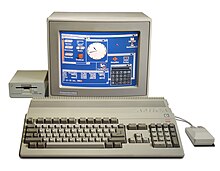
Back Amiga ALS أميغا Arabic اميجا ARZ Amiga Bulgarian Amiga BR Amiga Catalan Amiga Czech Commodore Amiga Danish Amiga German Commodore Amiga Greek
 | |
 The 1987 Amiga 500 was the bestselling model. | |
| Manufacturer | Commodore International |
|---|---|
| Product family | Amiga |
| Type | Personal computer Game console (CD32) |
| Release date | July 23, 1985 (Amiga 1000) |
| Introductory price | Amiga 1000: US$1,295 (equivalent to $3,670 in 2023) Monitor: US$300 (equivalent to $850 in 2023) |
| Discontinued | 1996 (Amiga 1200 & 4000T) |
| Units sold | 4.85 million[1] |
| Operating system | AmigaOS on Kickstart |
| CPU | Motorola 680x0 @ ≈7+ MHz |
| Memory | 256 KB and up, expandable |
| Predecessor | |
Amiga is a family of personal computers introduced by Commodore in 1985. The original model is one of a number of mid-1980s computers with 16- or 16/32-bit processors, 256 KB or more of RAM, mouse-based GUIs, and significantly improved graphics and audio compared to previous 8-bit systems. These systems include the Atari ST—released earlier the same year—as well as the Macintosh and Acorn Archimedes. Based on the Motorola 68000 microprocessor, the Amiga differs from its contemporaries through the inclusion of custom hardware to accelerate graphics and sound, including sprites and a blitter, and a pre-emptive multitasking operating system called AmigaOS.
The Amiga 1000 was released in July 1985, but production problems kept it from becoming widely available until early 1986. The best-selling model, the Amiga 500, was introduced in 1987 along with the more expandable Amiga 2000. The Amiga 3000 was introduced in 1990, followed by the Amiga 500 Plus, and Amiga 600 in March 1992. Finally, the Amiga 1200 and Amiga 4000 were released in late 1992. The Amiga line sold an estimated 4.85 million units.
Although early advertisements cast the computer as an all-purpose business machine,[2][3][4][5][6][7] especially when outfitted with the Sidecar IBM PC compatibility add-on, the Amiga was most commercially successful as a home computer, with a wide range of games and creative software. It also found a niche in video production with the Video Toaster hardware and software, and Amiga's audio hardware made it a popular platform for music tracker software. The processor and memory capacity enabled 3D rendering packages, including LightWave 3D, Imagine, and Traces, a predecessor to Blender.
Poor marketing and the failure of later models to repeat the technological advances of the first systems resulted in Commodore quickly losing market share to the rapidly dropping prices of IBM PC compatibles, which gained 256 color graphics in 1987,[8] as well as the fourth generation of video game consoles.
Commodore ultimately went bankrupt in April 1994 after a version of the Amiga packaged as a game console, the Amiga CD32, failed in the marketplace. Since the demise of Commodore, various groups have marketed successors to the original Amiga line, including Genesi, Eyetech, ACube Systems Srl and A-EON Technology. AmigaOS has influenced replacements, clones, and compatible systems such as MorphOS and AROS. Currently Belgian company Hyperion Entertainment maintains and develops AmigaOS 4, which is an official and direct descendant of AmigaOS 3.1 – the last system made by Commodore for the original Amiga Computers.
- ^ Cite error: The named reference
amigahistorywas invoked but never defined (see the help page). - ^ Cite error: The named reference
ad1987awas invoked but never defined (see the help page). - ^ Cite error: The named reference
ad1987bwas invoked but never defined (see the help page). - ^ Cite error: The named reference
ad1987cwas invoked but never defined (see the help page). - ^ Cite error: The named reference
ad1987dwas invoked but never defined (see the help page). - ^ Cite error: The named reference
ad1987ewas invoked but never defined (see the help page). - ^ Cite error: The named reference
ad1989was invoked but never defined (see the help page). - ^ Cite error: The named reference
reimerwas invoked but never defined (see the help page).